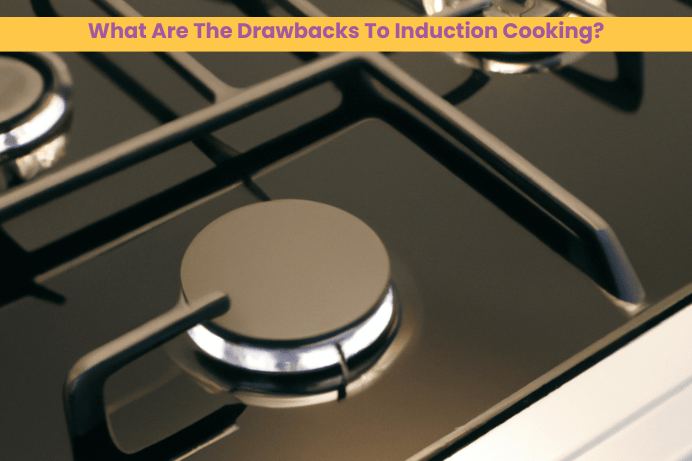What Are The Drawbacks To Induction Cooking? Quick to Reveal The Hidden Flaws Of Induction Cooking 2023
Induction cooking has become increasingly popular in the USA due to its efficiency and safety.
But does your kitchen need one?
However, like any technology, it has drawbacks that must be considered before purchasing.
What are those drawbacks?
One of the main drawbacks of an induction cooktop is induction hobs only function with cookware made from ferrous metal. Specific pans made of stainless steel aren’t compatible with induction stoves; the same goes for aluminum, copper, ceramic, and glass. The most fantastic cooking pans are cast iron or steel that may be used with an induction stove.
In this article, we will discuss the induction cooking and provide you with the information you need to make an informed decision.
What Are The Drawbacks To Induction Cooking? Exploring To Take Care In Its Use.
Here are some potential drawbacks of using induction stovetops. On the whole, induction has my undying support, yet, it pays to be well-prepared, as with any other purchase.
1. Higher Cost Of Induction Appliances
A comparable gas or traditional electric cooktop will cost less than an induction cooktop of the same size, but this is because induction is still a relatively new technology. However, it’s worth noting that the increased energy efficiency of induction cooking can help offset these costs over time.
2. You’ll Need Some Specialized Kitchen Equipment
For the induction method to work correctly, magnetic cookware is required. Some people may need to buy additional cookware and an induction stovetop for this to work.
3. You Will Need to Start Preparing Early On
While not always a drawback, induction cooking appliances are quicker than standard electric stoves. The stove will heat up quickly, so you should chop your vegetables before you turn them on.
4. If The Power Goes Out, You Won’t Be Able To Make Your Dinner
Fans of gas ranges know the value of enjoying a hot meal during a blackout. Induction cooking dont give you a chance because it works with electricity.
5. Noise and Vibrations
Induction cooktops can produce a humming noise and slight vibrations while in use. While this may not bother some people, others find it annoying or distracting, particularly if they’re sensitive to noise. It is something to remember if you’re considering induction cooking and plan to use it frequently.
6. Risk of Electromagnetic Interference
Another potential drawback of induction cooking is the risk of electromagnetic interference. Induction cooktops generate electromagnetic fields that can interfere with nearby electronic devices like pacemakers or hearing aids. While the risk is relatively low, it’s important to be aware of this potential issue if you or someone in your household relies on electronic medical devices.
7. Requires a Dedicated Circuit
Finally, it’s worth noting that induction cooktops require a dedicated circuit to function properly. It means you’ll need an electrician to install a new circuit if you still need one in your kitchen. It can add to the installation’s upfront cost and may require additional planning and coordination.
Is it safe to eat food cooked in an induction cooker?
Although there is some concern about exposure to electromagnetic fields, induction cooking is still a relatively safe preparation method.
What are the main disadvantages of induction cooking?
The most common complaint about induction cooktops is that they are picky about what pots and pans may be used on them. Only the pan is heated by the electromagnetic field produced by the burner. That’s why a magnetic pan is required for use with it.
Could you use an induction stovetop regularly?
Up to 70% less energy is used while cooking with an induction cooker, with 90% of the generated energy going directly into the pan. It translates to less time spent cooking and less energy expended. With induction, no open flame or other combustible element is present, making it a safer option.
Is induction used in restaurants with chefs?
Chefs commonly favor induction cooking because it allows instantaneous heat production and fine-tuned temperature control by using a high-performance glass-ceramic surface.
Does induction use a lot of power?
When compared to conventional stovetops, induction models offer significant energy savings. The appliance converts nearly all of the input power into heat for cooking. Thus, it leaves no energy to waste. Energy efficiency is high even while using lower temperatures for cooking.
Conclusion
While induction cooking has gained popularity due to its many benefits, such as speed, efficiency, and safety, it also has drawbacks. Major concerns include the need for specific cookware, potential electromagnetic interference with other appliances, and higher initial costs. It’s essential to weigh the pros and cons before switching to induction cooking. Overall, induction cooking technology continues to evolve, and manufacturers are finding ways to address some of these issues, making it a viable option for many households.
Do you use an induction cooktop? Or a traditional gas stove?
Which one gave you the best results?
Share your experience in the comment section.




